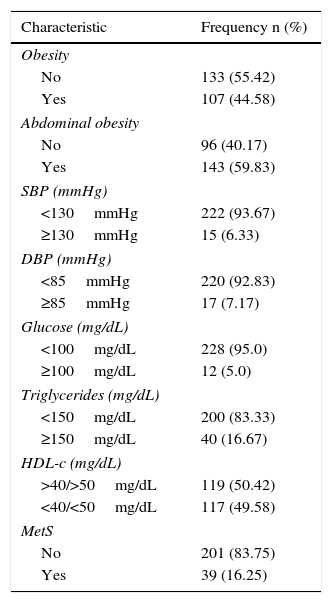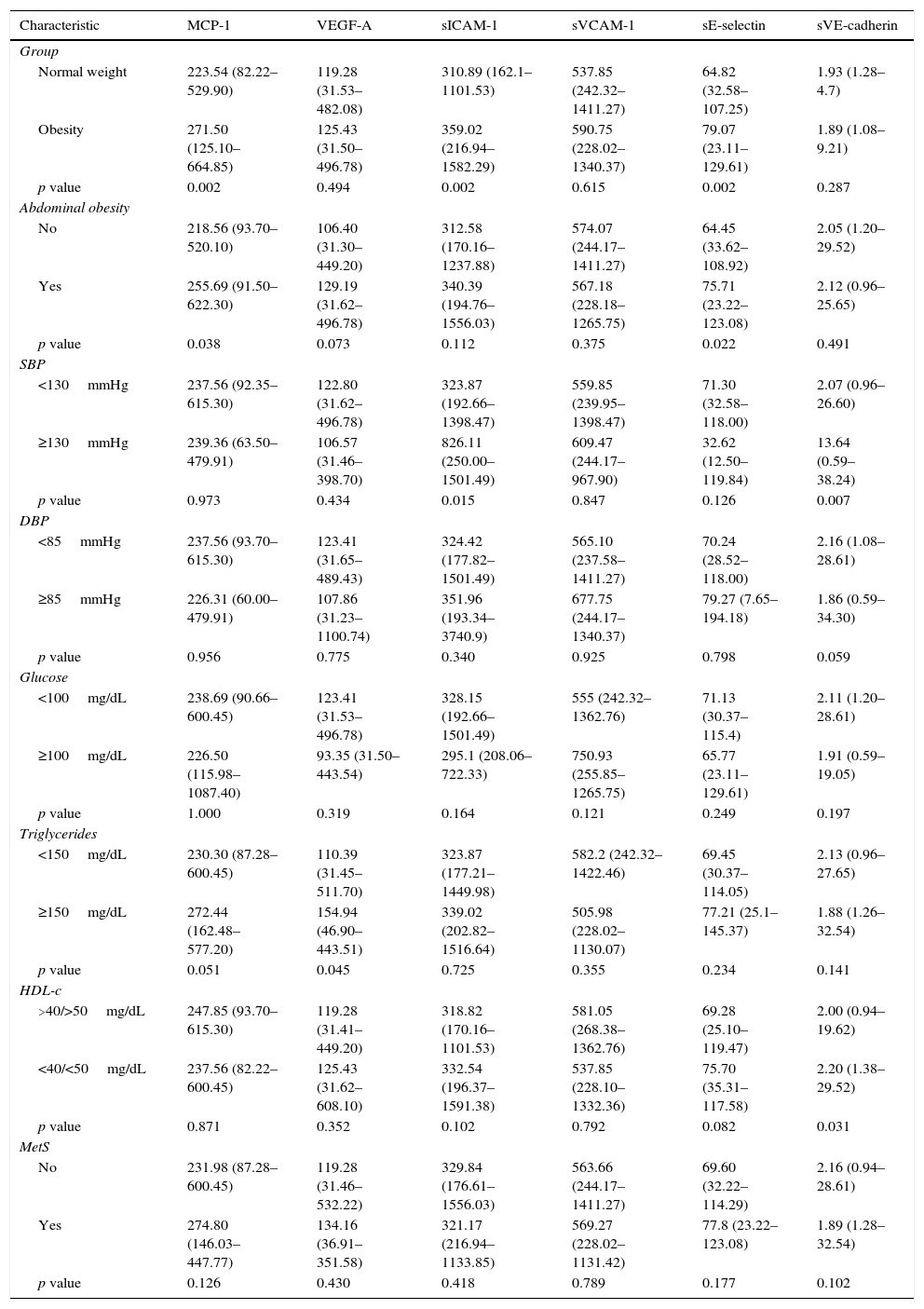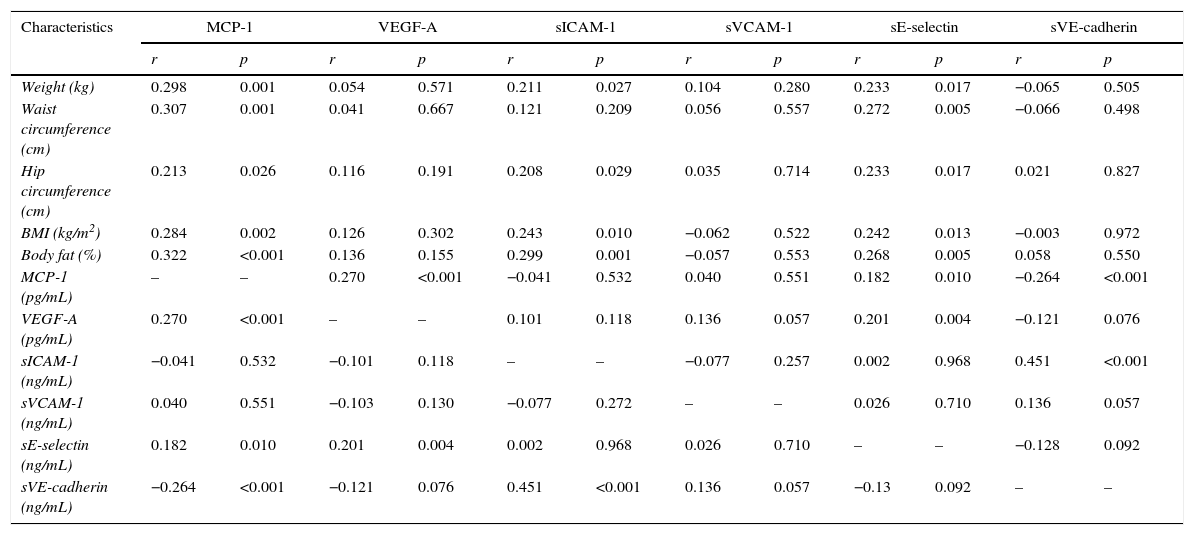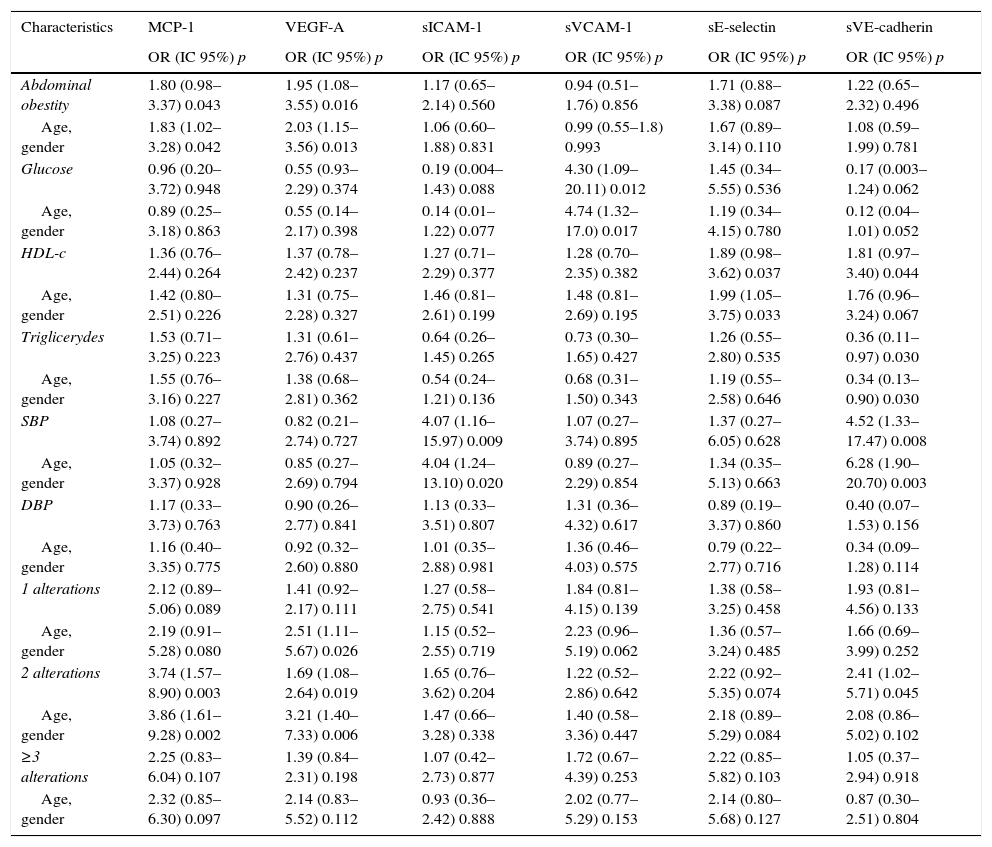Inflammation and endothelial dysfunction are considered the primary manifestations of the cardiovascular disease. Studies have established a relationship among components of metabolic syndrome (MetS) with inflammatory markers and the loss of permeability, vasoconstriction and vasodilatation endothelial.
ObjectiveTo determine the relationship among the concentrations of soluble endothelial dysfunction molecules and inflammation cytokines and components of the metabolic syndrome in young population.
Material and methodsA study was performed in 240 young adult students ages 18–28 years. To define the presence of clinical and metabolic alterations and MetS the modified ATP-III criteria was considered. In all subjects were determined sociodemographic characteristics, anthropometric measures and the metabolic profile. Circulating levels of MCP-1, VEGF-A, sICAM-1, sVCAM-1, sE-selectin and sVE-cadherin were determined by ELISA immunoassay (Bioscience). Statistical analysis was performed using STATA statistical software v. 9.2.
ResultsFrom all the participants, 44.6% had obesity, 59.9% had abdominal obesity, 49.6% low HDL-c and 16.7% high levels triglycerids. The 16.25% of the population showed 3 or more components of the MetS. Elevated MCP-1, sICAM-1 and sE-selectin levels were linked to the presence of obesity. In a model adjusted by age–gender, high soluble levels of MCP-1 and VEGF-A were linked with abdominal obesity (OR=1.83; 1.02–3.28 and OR=2.03; 1.15–3.56, respectively), as well as to the presence of the 2 components of MetS. sVCAM-1 levels were associated with impaired glucose (OR=4.74; 1.32–17.0); sE-selectin with low HDL-c (OR=1.99; 1.05–3.75), although sICAM-1 and sVE-cadherin were associated with impaired systolic blood pressure (OR=4.04; 1.24–13.1 and OR=6.28; 1.90–20.7, respectively).
ConclusionLevels of circulating MCP-1 and VEGF-A were associated with adiposity, levels of sVCAM-1 with the presence of impaired glucose, sE-selectin with low HDL-c, while the levels of sICAM-1 and sVE-cadherin were associated with impaired systolic blood pressure in young adults independently of other traditional risk factors.
La inflamación y disfunción endotelial son consideradas las primeras manifestaciones clínicas de la enfermedad cardiovascular. Diversos estudios han establecido una relación entre los componentes del síndrome metabólico (Smet), los marcadores de inflamación y la pérdida de la permeabilidad, la vasoconstricción y la vasodilatación endotelial.
ObjetivoDeterminar la relación entre la concentración de moléculas marcadores de disfunción endotelial, las citocinas inflamatorias y los componentes del Smet en población joven.
Material y métodosEstudio llevado a cabo en 240 estudiantes jóvenes-adultos con edades entre 18 y 28 años. Para definir la presencia de alteraciones clínicas y metabólicas se consideraron los criterios ATP-III modificados. A todos los estudiantes se les determinaron características sociodemográficas, parámetros antropométricos y perfil metabólico. Los niveles circulantes de MCP-1, VEGF-A, sICAM-1, sVCAM-1, sE-selectina y sVE-cadherina fueron determinados por inmunoanálisis ELISA (Bioscience). El análisis estadístico fue realizado utilizando el software STATA v. 9.2.
ResultadosDel total de participantes en el estudio, el 44,6% presentó obesidad, el 59,9% obesidad abdominal, el 49,6% niveles bajos de c-HDL y el 16,7% niveles elevados de triglicéridos. El 16,25% de la población mostró al menos 3 componentes de Smet. Los niveles elevados de MCP-1, sICAM-1 y sE-selectina se asociaron a la presencia de obesidad. En un modelo ajustado por edad y género los niveles de MCP-1 y VEGF-A se asociaron a obesidad abdominal (OR=1,83; 1,02-3,28 y OR=2,03; 1,15-3,56; respectivamente), así como también a la presencia de 2 componentes de Smet. Los niveles de sVCAM-1 se asociaron a la alteración de la glucosa (OR=4,74; 1,32-17,0), sE-selectina a c-HDL bajo (OR=1,99; 1,05-3,75), mientras que sICAM-1 y sVE-cadherina se asociaron a la presencia de presión arterial sistólica alterada (OR=4,04; 1,24-13,1 y OR=6,28; 1,90-20,7, respectivamente).
ConclusiónLos niveles circulantes de MCP-1 y VEGF-A se asociaron a adiposidad, los niveles de sVCAM-1 a la presencia de glucosa alterada, sE-selectina a c-HDL bajo, mientras que los niveles de sICAM-1 y sVE-cadherina se asociaron a presión arterial sistólica alterada en adultos jóvenes, independientemente de otros factores tradicionales de riesgo cardiovascular.










